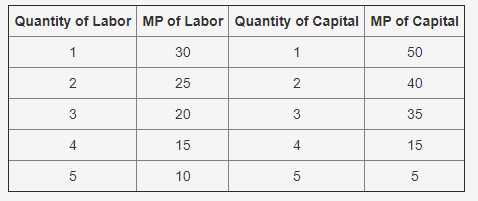Question
Thank you in advance! 1.If the wage in a perfectly competitive labor market is $20 and the marginal product of the last worker employed is
Thank you in advance!
1.If the wage in a perfectly competitive labor market is $20 and the marginal product of the last worker employed is 10 units, what must be the market price for the good being produced? Assume a perfectly competitive output market.
a.$10
b.$2
c.$200
d.$30
e. $22
f. $40
g.None of the above.
2.Assume that the demand for bicycles increases significantly at the same time that there is an increase in the number of people qualified to make bicycles. What would happen to the market equilibrium quantity of labor and wage rate for the labor to produce bicycles?
a.The quantity of labor and the wage rate both remain constant.
b.The quantity of labor increases, and the wage rate increases.
c.The quantity of labor decreases, and the wage rate increases.
d.The effect on the quantity of labor is indeterminate, and the wage rate decreases.
e.The quantity of labor increases, and the effect on the wage rate is indeterminate.
f.None of the above.
g.Only D and A.
3.Lets say the purchase of an additional unit increases the price of the unit and of the existing units being purchased. This describes:
a. monopolistic competition
b.perfect competition
c.a monopoly
d. a monopsony
e. an oligopoly
f.Other.
g.None of the above.
4.So, if the demand for a good decreases significantly, then what would happen...
a)the demand for the labor used to make the good increases
b)only the quantity demanded of labor for the good decreases
c) the supply of labor to produce the good will increase
d)the demand for the labor used to make the good decreases
e)the quantity of labor supplied to produce the good will decrease
f)None of the above.
g)A and B only.
5.If there was a monopsonistic market, the firms will hire where ________ equals marginal revenue product and pay a wage rate down to the ________.
a. marginal factor cost; product price
b. marginal factor cost; supply curve
c.supply; product price
d. demand; product price
e.demand; supply curve
f.None of the above.
g.A and D only.
6.Lets say a firm in a perfectly competitive labor market is employing labor where the marginal revenue product of the last unit is $20 and the marginal factor cost is $10.So, due to this the firm should...
a. lower its offered wage for labor
b. increase its offered wage for labor
c. employ fewer units of labor
d.use more capital instead of labor
e.employ more units of labor
f.None of the above.
g)employ the same units of labor
7.With the table respond to the question...

Step by Step Solution
There are 3 Steps involved in it
Step: 1

Get Instant Access to Expert-Tailored Solutions
See step-by-step solutions with expert insights and AI powered tools for academic success
Step: 2

Step: 3

Ace Your Homework with AI
Get the answers you need in no time with our AI-driven, step-by-step assistance
Get Started


